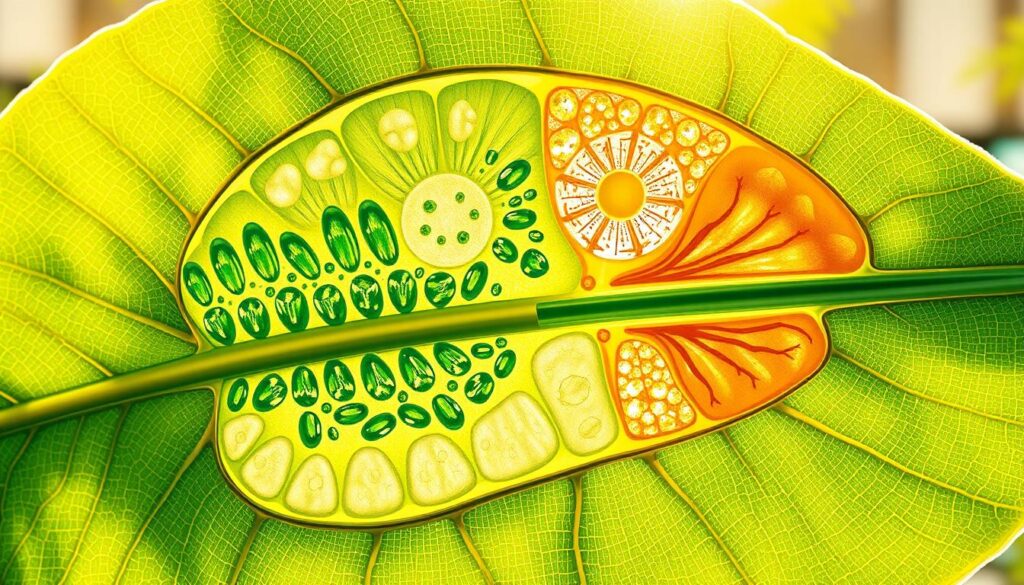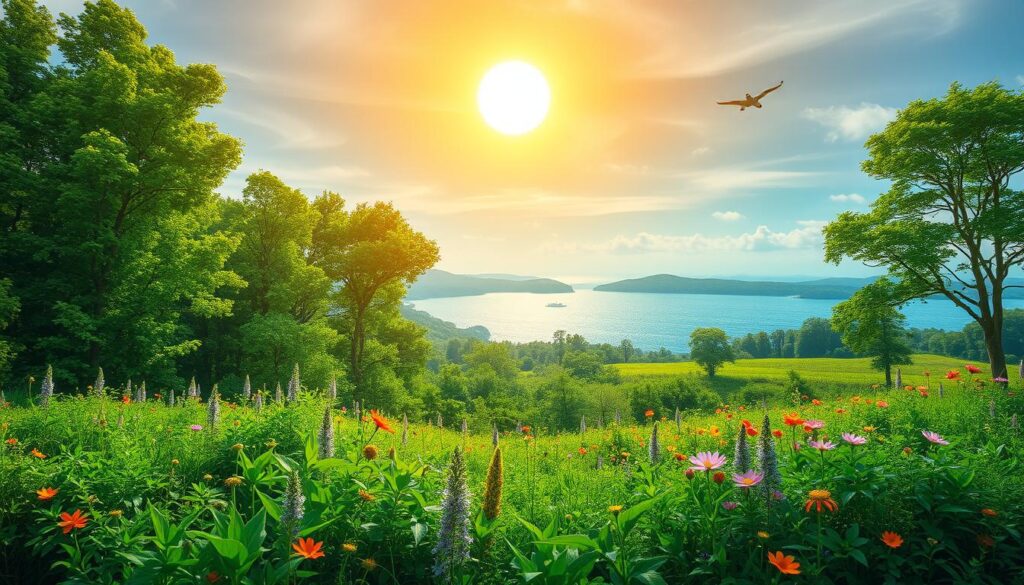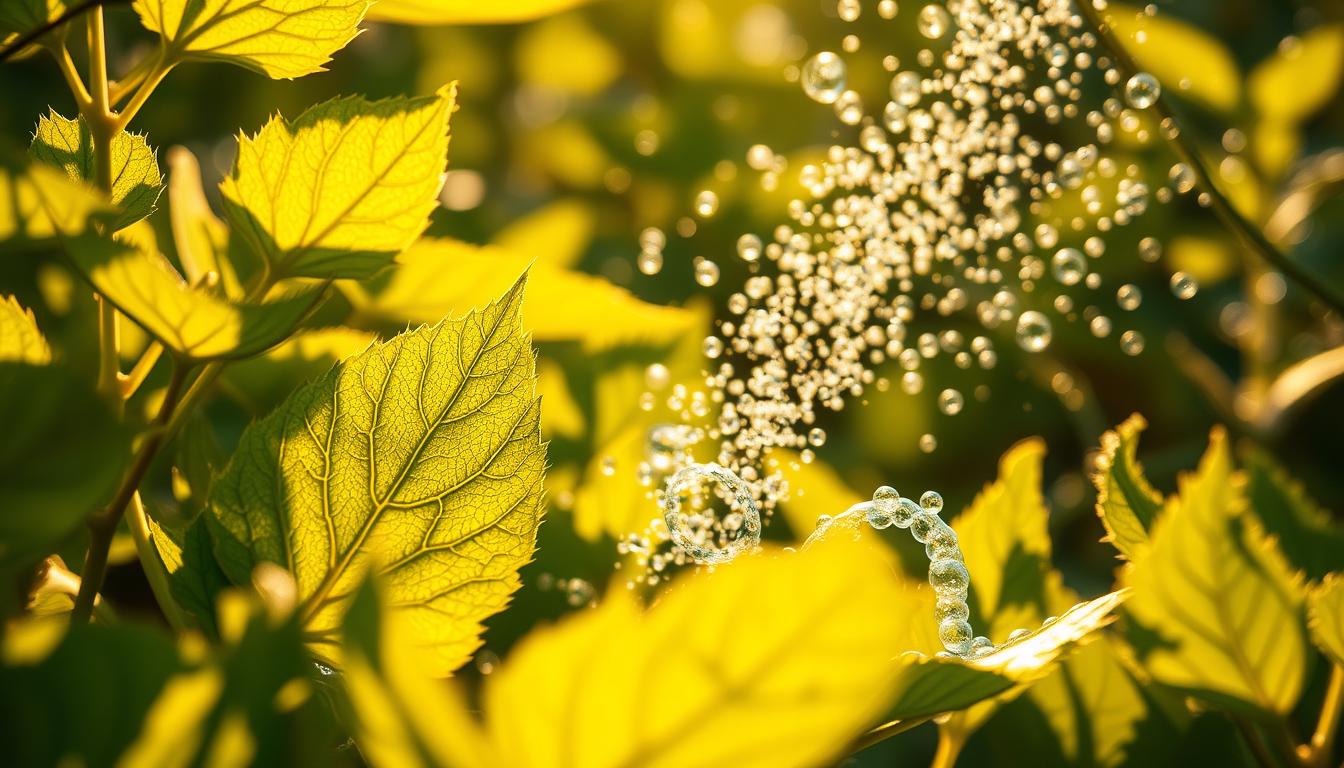Ever wonder how fresh air fills our atmosphere? The answer lies in photosynthesis, a natural process where green life forms turn sunlight into energy. Derived from Greek—“photo” (light) and “synthesis” (putting together)—it’s how leaves craft their own food.
Using water absorbed by roots, carbon dioxide from the air, and sunlight, they produce sugars for growth. The bonus? Oxygen is released as a byproduct, making every breath we take possible. Without this cycle, life as we know it wouldn’t exist.
Dive a leaf into water, and you’ll spot tiny bubbles—proof of this invisible gift. What happens if forests shrink? The delicate balance between humans and nature hangs in the air.
Key Takeaways
- Photosynthesis combines light, water, and CO2 to make food.
- Oxygen is a vital byproduct of this process.
- Leaves release visible oxygen bubbles underwater.
- Deforestation risks disrupting this natural cycle.
- Plants and animals depend on each other for survival.
How Do Plants Produce Oxygen?
Leaves act as tiny power stations, generating life’s essential gas. This process hinges on photosynthesis, where sunlight, water, and carbon dioxide transform into energy. Every part of a green organism plays a role—from roots to leaf tips.

The Role of Photosynthesis in Oxygen Creation
Tiny pores called stomata dot the undersides of leaves. These gatekeepers open to absorb carbon dioxide while releasing excess moisture. Inside leaf cells, chloroplasts—nature’s solar panels—contain chlorophyll to capture sunlight.
The magic unfolds with a chemical reaction:
6CO₂ + 6H₂O → C₆H₁₂O₆ + 6O₂
Here, carbon dioxide and water become glucose (sugar) and oxygen. Like humans metabolizing food,sugarsfuel growth, while oxygen escapes through stomata.
Key Ingredients: Water, Carbon Dioxide, and Sunlight
Roots stretch deep, their hair-like fibers absorbing water and nutrients. This liquid travels upward, merging with carbon dioxide in leaves. For peak efficiency, most green life thrives in bright, indirect sunlight—about 6–8 hours daily.
Pollution poses a threat: clogged stomata struggle to exchange gases. Yet, when conditions align, these natural factories tirelessly replenish Earth’s air—one leaf at a time.
Photosynthesis: The Process Behind Oxygen Production
Nature’s silent factories work tirelessly to sustain life. Inside every leaf, a two-stage process transforms sunlight into breathable air. This marvel hinges on tiny chlorophyll molecules, the unsung heroes of our ecosystem.

How Green Life Absorbs Carbon Dioxide and Water
Leaves pull carbon from the air through stomata—microscopic pores. Roots channel water upward, merging these ingredients in chloroplasts. Here, light-dependent reactions kickstart the magic:
- Sunlight splits water molecules, releasing energy and oxygen.
- ATP (adenosine triphosphate) forms in thylakoid membranes, fueling growth.
Converting Sunlight into Energy and Oxygen
The second phase, light-independent, uses ATP to craft sugars. Midday is peak production time—when sunlight is strongest. NASA notes oceanic phytoplankton contribute 50% of Earth’s oxygen, rivaling forests.
| Type | Adaptation | Oxygen Output |
|---|---|---|
| C3 Plants | Standard photosynthesis | High in cool climates |
| CAM Plants | Nighttime CO2 storage | Efficient in deserts |
Try this: Submerge a leaf in water. Bubbles appear—oxygen in action! Sun-loving species outproduce shade dwellers, but all face challenges like photorespiration in heat. Learn more about photosynthesis adaptations to dive deeper.
The Oxygen Cycle: Why Plants Matter for Humans and Animals
Every breath you take connects you to an invisible lifeline. Trees and green spaces silently replenish the air, making life possible for all living beings. This cycle balances ecosystems and sustains oxygen levels critical for survival.

How Oxygen Released by Trees Supports Life
A single mature tree produces about 260 pounds of oxygen annually—enough for two people. The Amazon rainforest, often called Earth’s “lungs,” generates 20% of the planet’s supply. Here’s how this lifeline works:
- Roots absorb water, fueling photosynthesis in leaves.
- Stomata release oxygen while trapping carbon dioxide.
- Forests maintain stable oxygen levels, unlike urban areas with higher pollution.
The Impact of Deforestation on Oxygen Levels
Globally, we lose 10 million hectares of forests yearly—equivalent to 27 soccer fields per minute. This destruction threatens:
- Soil health: Compacted earth starves roots of oxygen, reducing tree stability.
- Air quality: Fewer trees mean less oxygen available and more methane from waterlogged soil.
Solutions matter: Aerate compacted soil with garden forks, and use well-draining pots to prevent waterlogging. For more on protecting natural environments, explore our guide on fireproof home designs that harmonize with ecosystems.
Conclusion
Green guardians silently fuel our planet’s breathable air. Through photosynthesis, leaves transform sunlight into life-sustaining oxygen, a process as vital as it is invisible.
Urban gardens and towering trees alike contribute. Try the leaf-in-water experiment—those bubbles prove nature’s quiet work. Beware of algal blooms; they deplete oxygen at night.
Every native sapling planted boosts this cycle. Join local reforestation efforts or track air quality via citizen science apps. Together, we can make sure Earth’s lungs keep breathing.
Your action matters: Each seed nurtured echoes across ecosystems, weaving a healthier future.

